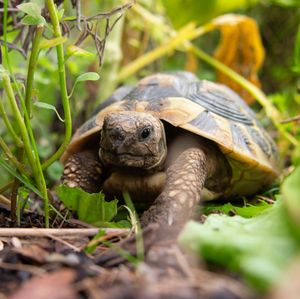
Greek, Hermann’s, Marginated, and Russian Tortoises
Testudo sp. and Agrionemys horsfeldii
Adult Size: 7-11+ inches (varies based on species)
Captive Lifespan: 50-70 years
Indoors: 4’ x 2’ tortoise table, Waterland Tubs terrestrial habitat, Zoo Med Tortoise House; avoid glass terraria.
When housing these species indoors use of a "tortoise table" or large storage tubs are recommended versus glass aquariums as these allow better ventilation and will prevent the tortoise from constantly trying to walk through the clear glass.
Outdoors: Minimum 4’ x 4’ predator-proof outdoor enclosure
As with most tortoises, these do better when kept in outdoor enclosures, especially in warm, arid climates. However, caution should be taken in wet, humid areas of the country as these species are prone to issues with both respiratory disease and shell infections when kept too wet. Outdoor enclosures should be moderately sized for adults, at least 4'X4' is recommended.
Indoors: Cypress Mulch, Chipped Coconut Husk
Outdoors: Topsoil, grass
Avoid: gravel, sand, cedar chips, pine shavings, aspen shavings
These tortoises are fairly temperature tolerant and are observed being active outdoors as long as highs remain in the 70s, however, little food should be offered with the lower temperatures. The preferred optimal temperature zone is between 85-95 degrees. Outdoors they will retreat into cooler burrows in hotter weather. Indoors, establish a temperature gradient within the enclosure with heat lamps and other overhead heating elements with a warm end of 85-90 degrees F and a cool end no cooler than 70 degrees F. Heat rocks should be avoided as they do not heat the enclosure adequately and can be a burn hazard for your pet.
Temperatures should always be monitored with a digital thermometer or infrared thermometer. Thermostats are also useful to ensure temperatures remain fairly constant within the enclosure.
Tortoises require UVB lighting to process calcium properly. UVB lighting should be provided using either fluorescent (tube or "spiral" bulbs) or mercury vapor bulbs designed specifically for use in reptiles. When selecting fluorescent bulbs the high-output 10.0 bulbs are recommended as tortoises require fairly high levels of UVB exposure. It should be noted that these bulbs will stop providing UVB long before they stop producing visible light so they will need to be changed regularly, usually every 6 to 12 months depending on the manufacturer's recommendations. Place UVB lighting no greater than 12 inches from the basking site. Connecting it to a timer is recommended to provide approximately 14 hours of light and 10 hours of darkness. For more information of UVB lighting, click here.
Feed Daily/Staple - Shrubs, Weeds, Forbs, Alfalfa (plants), Cactus pad/leaf (prickly pear), Cactus pear (prickly pear), Collard greens, Dandelion greens, Endive, Escarole, Mustard Greens, Squash (acorn, butternut, hubbard, scallop, spaghetti, summer), and Turnip greens.
Feed Occasionally - Alfalfa sprouts, Apples, Apricots (fresh), Beans (garbanzo, green, kidney, lima, pinto), Bell peppers, Blackberries, Blueberries, Cabbage (red), Cantaloupe, Carrots (raw), Celery, Cherries (no pit), Cilantro, Clover, Cranberries (fresh), Cucumbers, Grape leaves, Grapefruit, Grapes, Honeydew melons, Nectarines, Oranges, Pea sprouts, Peaches, Pears, Pineapple, Prunes, Pumpkin (raw), Radish, Raisins, Kelp, Strawberries, Watermelon, Wheatgrass (pet grass), and Yams (raw) .
Feed Rarely - Banana, Soybeans, Beet greens, Beets, Broccoli, Cauliflower, Corn, Egg (whole, hard-boiled), Kiwi, Lettuce (red leaf, romaine), Olives (canned, pitted), Parsley, Peas, Pomegranate, Potato, Raspberries, Rice, Rutabaga, Brussels sprouts, Starfruit, Swiss chard, Tomato.
Do NOT feed - Meat, Insects, Bran, Bread, Cheerios, Chives, Eggplant, Garlic, Lettuce (loose leaf, iceberg), Mushrooms, Onion, Pasta, Spinach*, or Yogurt
Juvenile tortoises (less than 2 years of age) also should be offered Mazuri LS pellets softened in water every 2-3 days to give them a small amount of protein and extra carbohydrates to help them build muscles and body condition.
Soak tortoises in shallow warm water for 15 minutes 2-3 times weekly to encourage drinking, urination, and defecation.
Indoor tortoises should be supplemented with a calcium carbonate powder mixed into their food twice weekly.
Indoors: Provide multiple hide boxes throughout the enclosure. One should be set up as a “humid hide” with moist sphagnum moss or similar substrates to provide a humid microenvironment for shell health.
Outdoors: Provide an artificial burrow and edible bushes and shrubs
Droppings should be removed as soon as possible. Disinfect the enclosure regularly using Rescue disinfectant or a mixture of 1 tablespoon bleach to 1 cup of water, make sure to rinse thoroughly afterward. Bowls should be disinfected at least weekly. Disinfect the entire habitat every 1 to 2 months again rinsing it thoroughly with water and allowing it to air out for at least an hour before returning your pet to the enclosure.
Copyright © All Rights Reserved
